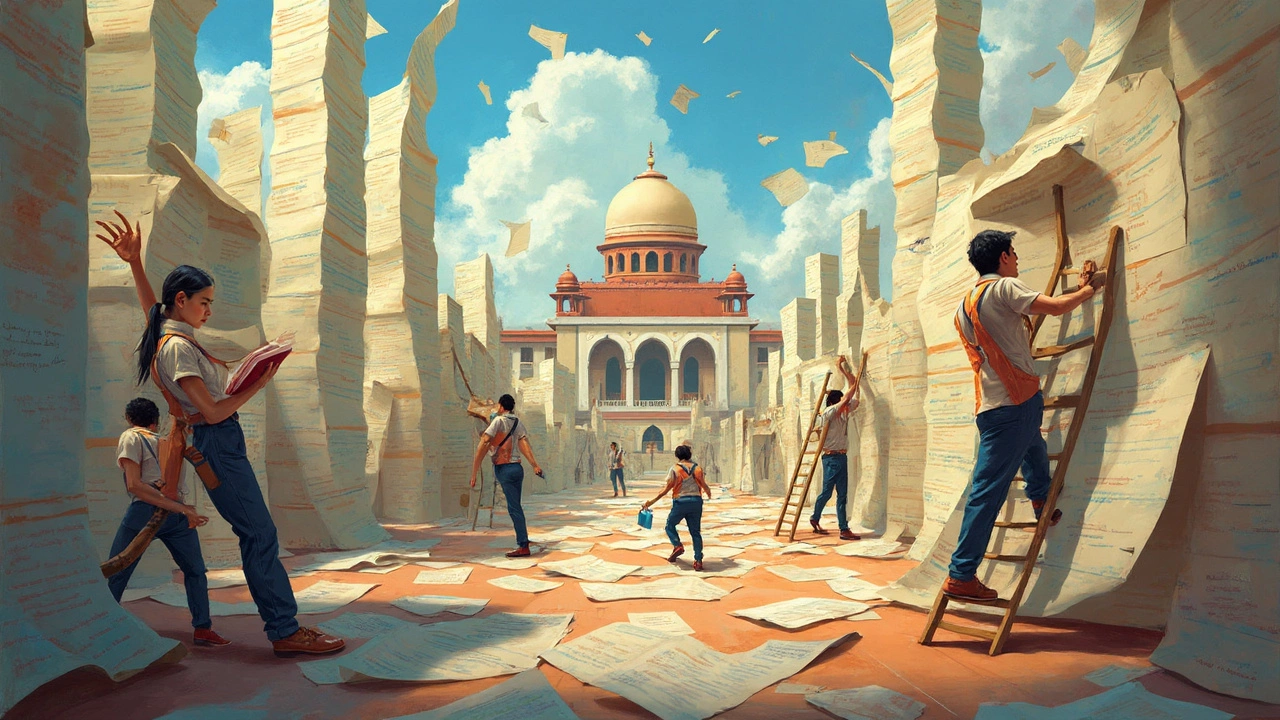When people joke about exams being “life or death,” they probably aren’t thinking of tests that actually make thousands cry, quit, or collapse. But these monster exams exist, and if you Google ‘hardest exam’, you’ll get stories that read like horror movies for students. Monster question banks, zero sleep, legendary low pass rates—some tests are less about knowing your subject and more about surviving the process without losing your mind.
So, what’s it like facing down the Goliath of exams? Think questions that twist your brain up like a pretzel, competition fiercer than anything you’ve seen, and pressure that’ll make your palms sweat two days before the date. Take the Indian UPSC Civil Services Exam or China’s gaokao—a single number on your scorecard can make or break your entire future. For medical students, the USMLE Step 1 or South Korea’s Suneung can still ruin summer plans (and more).
Wondering why some exams get so brutally hard? Part of it’s tradition, but a lot of it’s about squeezing the absolute best out of massive groups. The gears of society—top doctors, engineers, or officials—ride on the thinnest margins. And seriously, if you ever wondered why top scorers seem like robots, wait ‘til you see what they go through.
- The Usual Suspects: Which Exams Top the Legendary List?
- What Makes Them So Insanely Tough?
- Insane Facts from the Frontlines
- How People Train for Academic Battle
- Should You Even Try? Real Talk and Survival Tips
The Usual Suspects: Which Exams Top the Legendary List?
If you start talking about the hardest exam in the world, a few big names always pop up. We're not talking about your school finals or even the SAT. These are the real beasts—the ones that have entire industries built around just helping people survive the prep process.
First up is the Indian UPSC Civil Services Exam. Just over 0.1% of the million-plus people who take it every year actually make the cut. We're talking about a process that lasts almost a year and includes two written rounds and a face-to-face interview. It's the gateway to becoming one of India's top government officers, which explains why it causes all-nighters, coaching center gold rushes, and a lot of second thoughts.
Then there's China’s National College Entrance Examination, known as the gaokao. Every June, about 12 million high school seniors go full throttle for two days straight, trying to score high enough to get into a good university. Families move cities just for better prep schools, and some teens spend their last year on a gruelling 14-hour-a-day study schedule. A Chinese education expert once called it “a once-in-a-lifetime battle.”
Japan and South Korea aren’t far behind. The Korean CSAT (Suneung) is so intense that flights are grounded during listening tests so students don’t get distracted. The Japanese National Center Test for University Admissions can also make or break futures in a single shot. In the U.S., future doctors face the USMLE Step 1, famous for mind-numbing detail and gut-check anxiety.
| Exam Name | Country | Pass Rate | Noteworthy Fact |
|---|---|---|---|
| UPSC Civil Services | India | ~0.1% | More than 1 million applicants yearly |
| Gaokao | China | Varies by university | 12+ million students take it each year |
| CSAT (Suneung) | South Korea | About 5% | City activity literally stops during the test |
| USMLE Step 1 | USA | 96% (first takers), but harder than it sounds | Scores decide med specialties for life |
An ex-UPSC candidate sums it up best:
"It's not just about how smart you are. It's about how long you can stay in the game every single day for a year."
Bottom line—these exams aren’t just hard on your brain. They push your nerves, focus, and sometimes even your social life to the edge. Sounds dramatic? Just ask anyone who’s been there.
What Makes Them So Insanely Tough?
So, what pushes these tests easily into the “hardest exam” zone? It’s not just about the questions being tricky—it’s the whole experience, from insane competition to how much info you’re supposed to cram into your head. Let’s break it down.
- Volume of Content: Exams like India’s UPSC force you to cover topics ranging from world history to quantum mechanics. The gaokao in China isn’t any less wild—you’ll see math sneak attacks, obscure ancient Chinese, and science that leaves students shaking.
- Low Pass Rates: A lot of these tests are designed to fail most people. For example, the UPSC pass rate hovers around 0.2%. Japan’s National Bar Exam sometimes spits out fewer than 30% successful candidates even on a good year.
- Time Pressure: These aren’t all-nighters. You get minutes per question and sometimes hours of straight testing, back-to-back. Suneung in South Korea runs over 8 hours—with bathroom breaks controlled by guards.
- Emotional Stress: With entire careers riding on one result, kids prep for years, cram in “cram schools,” and sometimes face family or social pressure to the breaking point.
Check out how a few of these notorious exams stack up by the numbers:
| Exam | Country | Pass Rate (%) | Test Length (Hours) | Applicants/Yr |
|---|---|---|---|---|
| Gaokao | China | ~4.2 | 9 | 12,000,000+ |
| UPSC | India | 0.2 | 32 (over stages) | 1,000,000+ |
| Suneung | South Korea | N/A* | 8 | 550,000+ |
| USMLE Step 1 | USA | ~92 (but for med grads only!) | 8 | 40,000+ |
*Suneung doesn’t have a pass rate because it’s a ranking exam for university entry. Cutoffs are brutal for top colleges.
Another killer factor: the unpredictability. The questions aren’t just tough—they’re sometimes weird, unexpected, or way outside what you braced for. People train for years and still end up blindsided. Plus, most of these exams have a single-shot policy: you fail, your shot at the top is probably gone.
That’s what lands these tests at the top of the hardest exam charts. Want to ace one? It takes more than intelligence. Serious stamina, grit, and a nerve of steel are required—plus a game plan that’s next-level smart.

Insane Facts from the Frontlines
Let’s get real—some of these exam stories basically sound fake until you double-check. Start with the UPSC Civil Services Exam in India. More than a million people sign up every year, hoping for a government job. Out of those, less than 0.2% actually make it. Statistically speaking, you have a better shot getting into Harvard. And the exam isn’t just one day—you’re looking at a marathon of three different phases over months.
China’s gaokao wins the stress Olympics in sheer scale. Students start prepping two or three years in advance. Every June, the country sort of stops: subways run early, police stop traffic for test-takers, and hotel rooms near test centers sell out months ahead. If you think that’s overkill, know this: a single point can mean the difference between a top university and having to rethink your entire career.
In South Korea, the Suneung is so legendary that planes don’t take off or land during listening tests. The entire country literally quiets down so students can focus. Parents pray outside test sites, and neighbors stay silent. If you feel anxious before exams, imagine that level of national pressure.
And don’t forget the CFA (Chartered Financial Analyst) exams. People joke that passing the CFA is harder than becoming a Navy SEAL. On average, candidates spend more than 300 hours studying—per exam level. The overall pass rate for all three CFA levels? Just about 10% if you go straight through in three years. Most people don’t.
If you’re aiming for a shot at the hardest exam, you’d better be ready for some wild obstacles: insanely low pass rates, months of prep, and stress that goes straight to your bones. The real-world stories give the stats true weight—there are people who spend years training, move cities, and even quit jobs just to get a fighting chance. Makes your last math midterm look like a warm-up, right?
How People Train for Academic Battle
If you think studying for a hard midterm is rough, prepping for the world’s hardest exam is a whole different beast. This isn’t just about memorizing facts—it’s a daily grind that lasts months, sometimes even years. Let’s get into exactly how people tackle these monsters.
First off, serious contenders usually build a strict schedule. For something like India’s UPSC Civil Services, folks start prepping at least a year ahead, sometimes even two. Typical days run between 6 to 12 hours of focused studying—yes, weekends too. Chinese students facing the gaokao often live in dorms with no phones allowed, hitting the books well past midnight. Japanese students at yobiko (cram schools) prepping for university entrance exams sometimes log similar hours.
Common steps serious exam-takers follow:
- Mapping out the syllabus and sticking practice questions on every blank space (walls, notebooks, bathroom mirrors—you name it).
- Taking full-length practice exams, often once a week or more, to build stamina and speed.
- Using “active recall” and spaced repetition, not just reading notes but quizzing themselves out loud, over and over.
- Joining group sessions or online forums where everyone shares doubts, tips, or just vents about stress.
- Tracking performance with spreadsheets or old-fashioned diaries, marking weak spots daily.
Some even hire personal tutors, or spend thousands on coaching centers like those in Kota, India, which see about 200,000 teen test-takers cycle through every year. These places are infamous for squeeze-the-last-drop routines: daily quizzes, surprise drills, and relentless teacher pressure. For exams like the USMLE Step 1, it’s common to see med students investing over $2,000 in Qbanks, review books, and crash courses.
Here’s a quick look at the average effort for the toughest tests:
| Exam Name | Average Prep Time | Typical Daily Study Hours | Common Strategy |
|---|---|---|---|
| UPSC (India) | 1-2 years | 6-12 hours | Coaching + Self-study |
| Gaokao (China) | 2-3 years | 8-12 hours | Cram Schools |
| USMLE Step 1 (USA) | 12-18 months | 6-10 hours | Qbanks + Flashcards |
| Suneung (South Korea) | 2 years | 8-10 hours | Cramming + Mock Tests |
On top of everything, coping with stress is part of the routine. Most successful candidates build in physical activity—quick jogs, yoga, or even video game breaks—to keep their minds from short-circuiting. Chugging coffee is almost a given, and some researchers say that up to 40% of highly committed candidates battle sleep issues or burnout by the halfway mark.
No big secret weapon here. The grind is relentless, the focus is intense, and the ones who stick to their system are usually the ones who make it to the finish line.

Should You Even Try? Real Talk and Survival Tips
So, you've read about the toughest exams, and you’re probably thinking, “Am I seriously going to do this?” The truth? Nobody just wakes up and breezes through the hardest exam. Even the top scorers have moments of panic, doubt, and caffeine overload. Choosing to take on something like the USMLE, UPSC, or Gaokao is a major life decision—not just another school test—so it’s worth a hard look before you jump in.
Here’s the reality check: Most of these ultra-tough competitive exams have pass rates that are straight-up scary. UPSC’s main exam can have success rates as low as 0.2%. Gaokao is famous for sending families into full-blown crisis mode, and the Japanese bar exam (Shiho Shiken) once had a pass rate under 3%. These aren’t just numbers—these are years of sweat, and sometimes heartbreak.
Honestly, don’t do it just because other people expect you to. If this is really your dream—or the only way into a job you actually want—then buckle up, but know what you’re signing up for. The process is as much about keeping your head straight as it is about knowing your material.
- Hardest exam or not, having a realistic plan is key. Most successful test-takers recommend breaking down studies into daily, trackable goals. Don’t cram. Marathon, don’t sprint.
- Prioritize your mental health. If you think pushing 12 hours a day is strong, think again—it burns people out fast. Real talk: It’s the folks who build in breaks, social time, and real sleep who last till the end.
- Mock tests are your best friends. Treat them like the real deal—timed, strict, no distractions. The more you practice, the less you freak out on the actual day.
- Find a support system. Whether it’s peers who are in the same struggle or a family member who respects your crazy schedule, don’t isolate yourself. Study groups can boost your understanding and break the stress.
- Don’t ignore the official resources—most exam boards publish detailed syllabi, sample questions, and sometimes even answer keys. Print these out, and pin them next to your study space. They’re your map, not just suggestions.
If you decide not to chase the hardest exams, that’s okay, too. Success isn’t one-size-fits-all. But if you do go for it, go in with your eyes wide open, and commit fully. Few things feel as good as conquering what everyone says is impossible—just make sure it’s what you actually want.




